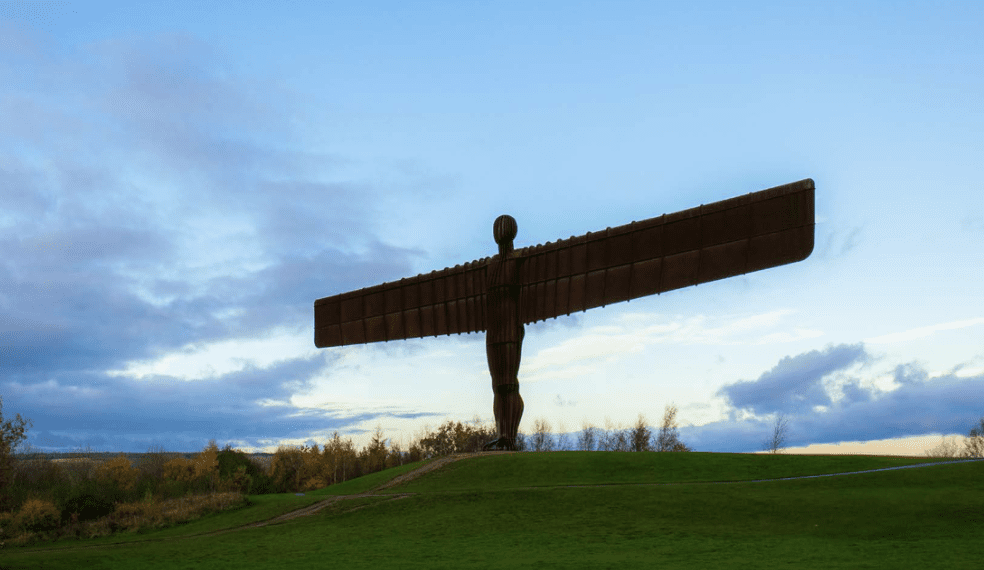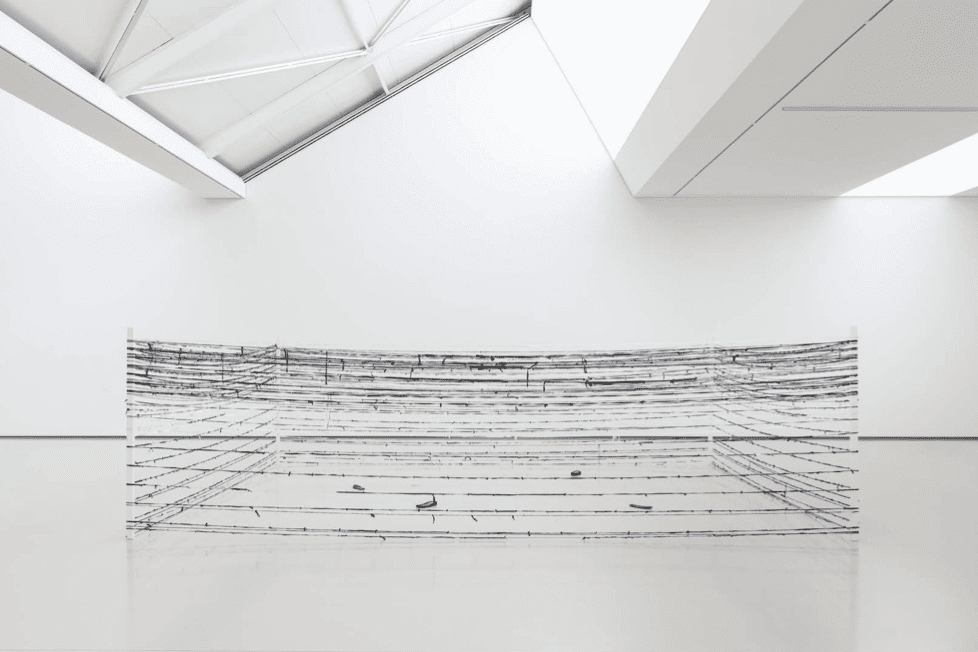
You have a very clear way of explaining your creations.
I don’t really trust thinking, per say. I think what I have to offer the world is principally through the objects I make, which is a form of physical thinking—because it’s connected and rooted in earth. I think speculative thinking, which I perhaps overindulge in, is a way of understanding the world, but I think the best is to actually get a hold of something and shape it in a meaningful way. My proposal to the world is that I’ve got to take a bit of the material world closest to me, and use my intuition, which I’ve built over the past forty-five years. I started with making Breadline, which was a simple idea: rather than doing a picture, can I take these twenty-three slices of Mother’s Pride bread and describe it in a way that is also an experience? In the process of making that work, it became a redescription in the way it is experienced. The translation of something physical that is close to our bodies became metaphorical of something bigger, about the body. That work led on to Bed, which was then complimented by Room—a collection of clothes given to me by parents while I was at school. Anyway, those two works, Bed and Room, gave me no option but to deal with the body, which is my primary material. I never thought in 1980 that I would still be doing it in 2023, but you don’t have a choice. Making art is a vocation.

Your work is between the material and the metaphorical.
I exist between the two because I want my work to be existential. They are material propositions that investigate life in the end. That’s the only subject art can have: life. But then it’s a question of how you attack it, and I do this in the most visceral, primal and hopefully confrontational way through the body. Then I tried to consider the logical positions, and I thought, well, I’ve got to somehow deal with the body not as a thing that needs to be made perfect, but as an evocation of a place in which we live. The body forms that I’ve made are industrialised fossils—lived moments taken out of human time. They are specific and highly subjective, but they are also an example of the common human condition. I want people to ask, what is this human body? How does it fit in with relation to the horizon, and how does it sit on the grass?
You brought so much beauty to this philosophy with your work in Delos. Would you go somewhere like that again?
That was magic. Who would have thought some jobbing sculptor from this little island would be given the birthplace of Apollo? It’s always a matter of being invited to do these things. I am fascinated by how forms made from different eras can speak with each other. Through that, the object of sculpture can change, and also affect how we see what is already there. This has always been the most exciting thing for me—let’s put a sculpture in the mountains, on the beach, and see how that changes the way we feel about these spaces. It was the same in Delos.

Can you tell us about the influence of Brancusi on your work?
For sure, going to his studio when I was a student, and just feeling this spaceship of white space with no windows, entirely in its own world, with plaster and stone dust, and somehow feeling that this is a crucible in which new things can arise in the world…I think Brancusi and Giacometti, both in very different ways, determined the conditions of their own work and space uncompromisingly. As it were, Brancusi made very few works that exist in the elements and in a collective space. This is the tragedy of the 20th century; in defining the artist as the icon of the liberated individual, sculpture lost its social potential. That’s something that I’m desperate to put forward, because art is an incredible gift and it only begins to have value when it is shared. The commodification and privatisation of art has happened in incremental and exponential ways. You only have to look at how London has changed over the past thirty years—its value has been defined by market forces. From the beginning, I’ve wanted to overturn that. My absolute conviction is that we must release art from the auction room, the private gallery and museum. The latter is a necessary hospital for art that has lost its place. What sculpture can do is give a focus to the life of a place.
It’s a confusing time. Is this a matter you bring to the hierarchy in the art world?
I think that it was in trying to make The Brick Man in Leeds in 1984, and going on to successfully make Iron:Man in Birmingham, and then the Angel of the North, that my conviction that sculpture has a job to do in the collective spaces of human lives was strengthened. And although we’re drenched in crappy 19th century bits of Victorian public statuary, that doesn’t mean the potential of an imaginative object within a shared space is not enormous. And maybe we have to go back to the pre-modern in order to see how that works. The long houses in Northwest British Columbia, or a totem pole marking a space that connects the earth to the sky, all establish a relationship between human life and the elemental world. That’s what the Angel of the North is about. Who are we? Where are we? What do we do? In that case, it is a shipbuilding mining community that has been long exploited. I said, we have to make a sign above ground that will be read against the sky, and have, in a way, the shaft and seam of a coal mine. But we’re going to make it human and with the skills and materials that were endemic to this area. The Angel is in some ways my Măiastra, 1911 by Brancusi.
The North of England and India had a huge influence on you. Which one of these breezes follows you closest?
Being sent up to school in Yorkshire was my grounding. Without the North Yorkshire moors or Fylingdales, everything would be different. I insisted to my wife Vicken when we were first together that we go look at Fylingdales, and I remember looking at these incredible objects and what they were telling us about the world we live in. Schooling at Ampleforth was important because it encouraged my instinct to make things: my first radio at fourteen, two boats, and I founded the pottery club. I was always in the art room. It wasn’t just essays, I owe that school a lot. I had the tools for self-determination, and today the attitude to curricula is so instrumentalized that we’re being turned into drones. It’s the pressure of late capitalism on these poor souls that are unable to blossom in an atmosphere of heady exchange of inflammatory ideas. But I also think that going to Yorkshire was the opening to me of the elemental world and the power of landscapes. It’s where the bones of Britain express themselves.

Without India I would have nothing. I hitchhiked to Istanbul and took buses to get to Kathmandu in 1969. I’ve never been back there, but it was a revelation to me. I think, along with watching the films of Malcolm McGrath, I also took with me Mao’s Little Red Book—we didn’t see the dark side at that time. We saw the brilliant idea that scholars should plant spring onions in fields and that farmers should learn poetry. Along with the other spiritual guides of the East, they were doorways into a new value system. I finally got to India in 1972 and stayed for two years studying under Kalu Rinpoche and S. N. Goenka. I had the choice of staying and becoming a monk, and achieving a sort of liberation, or going back home. I became quite good at drawing and painting, but I wanted to deal directly with the world and that is what sculpture does.
Why did you want to deal with the world directly?
It’s placing an object that didn’t exist before and transforming something that has already existed. You put it in the world, and you see what happens. The physical absoluteness of sculpture is something that thrills me every minute of the day because it’s so direct. It’s about making the palpable intelligible. And in this increasingly Metaverse world, the potential of sculpture to reroute you in a first-hand experience is valuable. It’s like, “Here’s this object, and what’s it doing in my world?” So you sniff and see what it’s made of, and try to get to the bottom of it, and in the process you find parts of yourself you wouldn’t have otherwise discovered.
Is there a place you would like to transform with your sculpture that you haven’t?
I actually have had this long ambition not to make an object, but to make a space somewhat similar to the Pantheon and place it underground. Either south of the Taklamakan or in Kazakhstan. But I would like to do it using the combined armed forces of Russia, China and America. This is a very stupid, Utopian project, but my feeling is that our species don’t have very long. So if we make a space for the collective, so that collective meditations can unite collective futures, that would be a good thing





